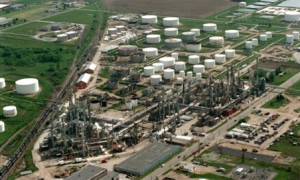The U.S. Energy Information Administration (EIA) conducts annual and monthly petroleum refinery surveys among U.S. refiners. The annual survey (Form EIA-820) asks refiners to provide purchased natural gas, electricity and steam as process fuels for refinery operations. The survey results are summarized in EIA’s Annual Refinery Capacity Report (EIA, 2007a). By law, all refineries are required to respond to EIA surveys. In this regard, the coverage of petroleum refineries by the EIA should be complete. But is it?
In the annual survey, the EIA specifically asks refiners not to include natural gas consumed for hydrogen production. EIA does not ask about MTBE and ethanol inputs either. On the other hand, EIA asks in its monthly survey (Form EIA-810) inputs of hydrogen, MTBE, ethanol, and other items to refineries. This EIA survey data or results from refinery linear programming (LP) simulations form the basis for calculating refinery energy efficiencies.
According to documents from the EIA, energy contents of all refinery products, including those less marketable products with shrinking demand must be included. Some of these low demand refined products include asphalts, road oils and bunker fuels. Otherwise, if these products are not included with other high value refined products, such as diesel and chemical grade propylene, then the refinery’s calculated energy efficiency would be lower than expected. The EIA provides an example to emphasize this point by noting that if energy in asphalt, road oils and other miscellaneous products are omitted from the refinery energy output calculation, then overall U.S. refinery energy efficiency would decline from 90.1% to 86.4%.
Outside the U.S., other types of metrics may be considered as the basis for measuring refinery energy efficiency. For example, a guest blogger in one of the recent issues of the Oil & Gas Post, Helmut Koerber, discussed key points to refinery energy efficiency by using the OMV refinery in Austria as an example. At a recent European Refining Technology Conference (ERTC), this facility was acclaimed with high efficiency ratings, while Koerber noted that the facility was able to produce an additional 20 megawatts (MW) of energy by further improving energy efficiency.
Koerber first pointed out that when discussing technical questions with OMV plant engineers, a special drawing occasionally needed to be retrieved simply to understand a specific detail within the OMV complex. In certain instances, it is not an easy task to find the correct document, against a backdrop of thousands of other documents that have been added or modified over the years. OMV’s ability to rapidly retrieve a specific document is a reliable indication that the company is technically well managed, according to Koerber. “The engineers of this refinery always managed the task within two-to-three minutes,” said Koerber. It therefore stands to reason that “efficiency” in general can lead to improved plant energy efficiency.
With an already efficient refinery demonstrating Best Practices, Koerber and the OMV staff sought to ascertain how the plant could produce more power by improving energy efficiency. While most refineries in the U.S. are not configured to generate their own electricity (cogeneration), facilities in Europe and elsewhere value cogeneration of steam and electricity as a monetizable refined product, selling excess output to the local grid for industrial and municipal consumption.
In this instance, with the OMV facility targeting higher output, it needed to generate more electricity and high pressure steam driving power (for turbines, pumps, etc.), thereby burning more fossil fuels, such as offgas. Koerber noted that this Austrian refinery is under the CDM carbon trading regime, which requires the refiner to pay for the additional CO2 released into the atmosphere. A simulation model was developed for the refinery and its energy flows. According to Koerber, this approach led to the discovery of several improvements for much better use of energy, including more than 20 MW of additional power without burning one additional droplet of fuel!
Koerber concluded that within a very well organized and engineered refinery, tens of additional MW of energy efficiency can be uncovered. “Obviously, there is an incredible potential for identifying, measuring and increasing energy availability in an already efficient complex,” Koeber noted.








Leave a Reply
You must be logged in to post a comment.